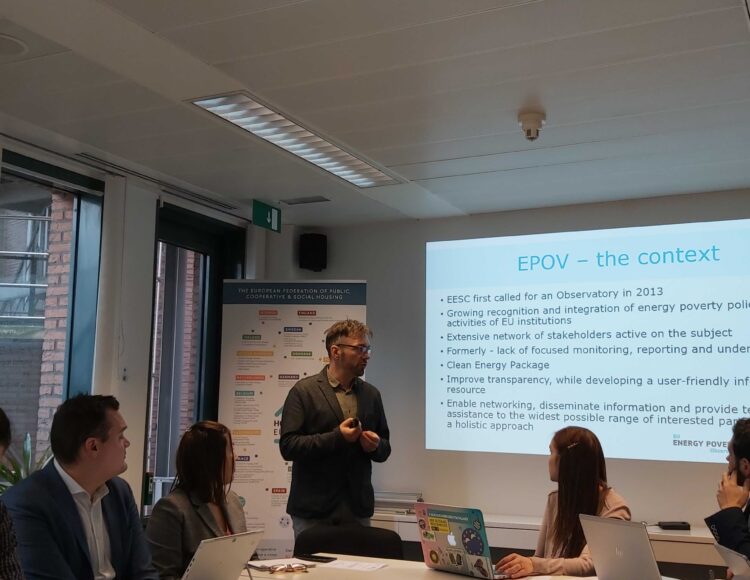On March 3rd, Housing Europe co-organised a workshop session with the European Policy Centre (EPC) and the European Poverty Observatory (EPOV) the importance of the district/local level in fighting energy poverty in the light of the European Green Deal. In discussing the district approach to energy poverty the session focused on two elements : first, the role of housing providers in reducing energy needs and second, the combination with production of energy at the district level.
It has become evident that energy poverty is one of the most alarming phenomena of our times, affecting around 11% of Europeans. Eurostat (2012) shows that 87 million people live in poor quality dwellings, 54 million people cannot keep their home adequately warm and 161 million face disproportionate housing expenditure.
At the same time, the number of people with complex housing needs in Europe is increasing, especially in those countries hit most by the financial crisis. In Greece, for instance, according to the latest European Parliament survey, 36% of households suffer from energy poverty, while tens of thousands of them have no access to power and/or heating.
There is no doubt that the challenge is multifaceted, characterized by poor energy efficient homes, rising energy prices and low income. Home owners and providers across Europe face different challenges from financing energy efficient renovations to providing additional services to tenants.
This challenge has been recognised by the European Commission in the EU Green Deal, since it says that “Particular attention will be paid to the renovation of social housing, to help households who struggle to pay their energy bills”.
In order to both achieve the targets and leave no one behind, more effective solutions should put in place to motivate Member States seeing the energy efficient renovation as part of future-proof and sustainable neighbourhoods.
Dr. Stefan Bouzarovski (University of Manchester and Chair of the EU Energy Poverty Observatory) explained that in many countries there is a ‘lack of integrated approach’ between the energy sector and social care sector to tackle energy poverty. In some Member States with rigid institutional social welfare systems, energy poverty is recognised as a social issue rather than infrastructural.
Decentralising energy production
VVH, the Association of Flemish Social Housing Companies, is tackling energy poverty through access to renewable energy via the ASTER project. The planned investment programme involved the installation of approx. 20.000 Photovoltaic (PV) panels in social housing units in Flanders. ASTER’s work aims at benefiting all tenants by sharing the energy produced by installations, by sharing the financial benefit from installations, and by combining both i.e. Renewable Energy Communities.
The role of local authorities’ energy planning
Giustino Piccolo (Covenant of Mayors for Climate and Energy EU Office) outlined some of the actions taken by Covenant cities to tackle energy poverty:
Reducing energy bills through interventions on buildings.
Promoting energy savings and cost-efficient behaviours.
Protecting energy consumers through mediation services.
Social measures shouldn’t counteract climate mitigation and adaptation.
The market price of the buildings rises in the long term – after energy efficiency renovations.
On-tax financing system for renovations where the energy debt is attached to the building, not the individual.
The one-stop-shop approach
One-stop-shops as physical district offices, assist the neighbours in the building renovation customer journey.
They offer a non-institutional space for neighbours.
They help increasing the awareness of homeowners for energy efficiency and energy poverty alleviation.
In the case of the OPENGELA project, District renovation had a multiplier effect where energy is not the main trigger at the start:
The Basque Authority’s involvement in the project, an essential factor that provided stability, vision and ambition to the project.
The district approach provided opportunities for higher implication of the private sector.
Open, accessible physical one-stop-shops multiplied the opportunities.
What can the EU do to promote the area-based approach?
Wim Hazeu (Wonen Limburg) believes that for a successful transition we need citizens to come on board. The neighbourhood level is the level from which people derive their identity. So it is exactly that level on which we, as housing providers, should interact with our tenants. We also need solidarity between income groups can be arranged at the neighbourhood level. And ultimately, a cost efficient transition is needed. Therefore we can not renovate house by house. Our aim should be to renovate district by district. Or as the European Commission formulated it in her European Green Deal Communication: we need to organize renovation into large blocks. Scale is crucial.
Charles Roarty (Energy Action Ireland) emphasised that communities are crucial to delivering the right results: when they are empowered and consulted, the right solution is chosen. Renovation has to be visible to get significant buy in, therefore, people need to be empowered by the renovation wave.
The technologies that we use need to be controllable by people who not have the skills to manage the controls of a building: for this the figure of a building manager is needed. People need to be empowered. Not only provided with smart technology.
According to him, the focus of the renovation work should be on the renovation of existing private buildings, currently left behind by member states. Instead, the focus is on new construction and public buildings.
Our way forward
First, the Climate Act should facilitate new platforms that Member States need to establish collaboration and dialogue between energy suppliers, social providers and the construction sector. Second, trusted and neutral spaces for tenants to bring down energy costs and improve living conditions are essential. Finally, quality insurance, quality renovation at a fast pace without interfering on the lives of individuals coupled with bringing down the costs by expanding the scale.
For more details on the outcomes of the event check this report.
